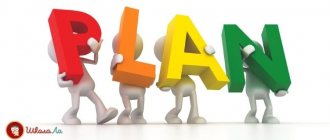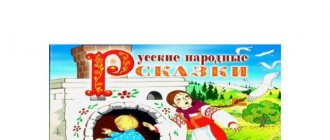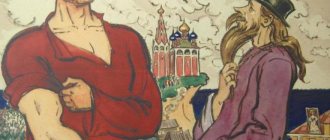MAGAZINE Preschooler.RF
Short-term project “Through the pages of Russian folk tales” in a preparatory school group.Project type: educational and creative.
Project duration: short-term project, 1 week.
Project participants: children of the preparatory group, teacher.
Children's age: 6-7 years.
Educational areas: speech development, artistic and aesthetic development, cognitive development, physical development, social and communicative development.
Relevance: Books are of great importance in a person’s life. A child’s strong interest in reading and reading habit are formed in the family. While the child is small, parents read books to him, and as soon as the baby learns to read on his own, they breathe a sigh of relief. It's no secret that many children grow up without loving a book. Most often, children read comics, sticker magazines, watch videos, play computer games, but the art book remains untouched and loses its importance in the formation of artistic taste. Children and their parents spend most of their free time watching TV or a computer; as a result, the reading process slows down and interest in the book is lost. Reading fiction is of great importance for the all-round development of a child. Their success in learning depends on how children understand the content of what they read, how they can read fluently and expressively, analyze the actions of characters, and draw conclusions.
Once a child begins to become interested in a book, he will find himself in a completely different world - fascinating, colorful, interesting, which will give him many discoveries and finds. The love of reading and books is a love for life, so it is very important to encourage a preschooler’s first successes in reading and storytelling, and to stimulate his interest in words and good works.
A baby book made by preschoolers will increase interest in fiction, give an understanding of the importance of books in a person’s life and increase children’s self-esteem for their work.
A baby book is both entertainment and a pastime with the child, as well as learning.
The most fertile soil, with unlimited developmental and educational opportunities, is the Russian folk tale.
Russian folk tales reveal to children the precision and expressiveness of the language, showing how rich their native speech is in humor, lively and figurative expressions. The amazing power of linguistic creativity of the Russian people has never manifested itself as clearly as in folk tales. Their inherent extraordinary simplicity, brightness, imagery, and ability to repeatedly reproduce the same speech forms and images make it possible to put forward fairy tales as a factor in the development of coherent speech in children.
Hypothesis: A fairy tale has an advantage over other educational techniques. This is a kind of moral code of the people, their heroics are, although imaginary, but examples of the true behavior of an honest person who knows how to stand up for his dignity.
A fairy tale plays a crucial role in the development of imagination - an ability without which neither the mental activity of a child during preschool and school education, nor any creative activity of an adult is possible. Fairy tales instill interest in reading fiction.
Difficulties in children developing coherent speech, the sequence of stories about the events of their lives, the ability to retell literary works, compiling stories based on a picture and a series of pictures, and compiling descriptive stories. Children's creative abilities are poorly developed.
Target:
To cultivate in children a love of books, as well as a love of Russian folk tales; develop in children a sustainable interest in fairy tales as a work of art; revealing children's creative abilities.
Tasks:
- To increase children's interest in independent reading activities.
- To develop the ability to plan the process of making a book - babies.
- Expand children's understanding of fairy tales.
- To develop in children the ability to independently select literature of interest.
- Development of fine motor skills of the hands.
- To develop imaginative thinking, imagination, and creative abilities in children.
- Foster feelings of friendship and collectivism.
- Foster a culture of speech.
- Foster love and respect for books.
- Education of aesthetic taste.
Planned results:
- Increasing the effectiveness of work on the development of coherent speech in children.
- Enriching children's vocabulary.
- Children’s use of elements of Russian folklore, comparisons, metaphors, epithets and other means of figurative expression in their speech.
- The ability to play didactic and printed board games, solve and compose your own riddles, solve crosswords and puzzles based on Russian folk tales.
- Application of acquired knowledge, skills and abilities in creative activities (creating a baby book).
Project product: Little book based on Russian folk tales: “Kolobok” , “Turnip” , “The Wolf and the Seven Little Goats” , “Zaykina’s Hut” , “Teremok” , “Masha and the Bear” , “The Fox with a Rolling Pin” , “Geese” swans" .
Expected results for the project:
- developing children's interest in Russian folk tales
- consolidation of the ability to apply one’s knowledge in conversation and coherent statements
- fostering a sense of friendship and collectivism
- get an emotional response from your work
- replenishing the book corner with handmade baby books.
Stage I “Preparatory”
- Studying literature on project activities.
- Preparation of methodological literature, illustrated books with Russian folk tales, illustrations based on the plots of Russian folk tales.
- Development of notes for joint activities, quiz scripts on the topic “What a miracle these fairy tales are!” .
- Enrichment of the developmental environment: in the book corner - the introduction of Russian folk tales, illustrated by various artists; illustrations, postcards depicting fairy tale characters as you study; in the speech zone - the introduction of didactic and board-printed games on the topic; production and gradual introduction of theaters (flat, tabletop, on sticks, on spoons, on cones, Bibabo, finger); masks in the playing area,
in fine arts - coloring books depicting plots and heroes of Russian folk tales, materials for creative works, reproductions of paintings based on Russian folk tales.
5. selection of visual and didactic material.
Stage II “Information and creative”
Cognitive development:
- SOD: “Russian folk tales” .
- FEMP (educational games): “Tsarevich Ivan saves Vasilisa the Wise” (labyrinth),
- Construction: “Build a castle for Helen the Beautiful” (builder); “Frog Princess” , “Firebird” , “Bunny” (origami).
Speech development:
1. SOD: Retelling the fairy tale “Fear has big eyes .
SOD: Storytelling based on a series of pictures “Fox-Sister and Wolf” .
SOD: Creative storytelling: . ”
2. Telling fairy tales using mnemonic tables.
3. Compilation of descriptive stories about heroes and magical objects of Russian folk tales. Children come up with riddles on the topic.
4. Didactic games: “What first, what then” , “What fairy tale did the hero (heroine) come from?” , “Which fairy tale is the magic thing from?” , “Choose an illustration for a fairy tale” , “Confusion” , “Add the picture and find out the fairy tale”
5. Reading fiction: “The Cockerel is the Golden Comb” (comparison with the plot of the fairy tale “The Cat, the Rooster and the Fox” ), “Geese-Swans” , “Sister Alyonushka and Brother Ivanushka” , “Sivka-Burka” and “Ivan the Tsarevich” and the Gray Wolf" (comparison of fairy tale plots), "At the behest of the pike" , "The Tale of Baba Yaga" , "Seven Simeons" , "Morozko" , "Snow Maiden" , "Finist - Clear Falcon" , "Flying Ship" , "Magic ring" .
Social and communicative development:
- Game-dramatization based on the Russian folk tale “Little Red Riding Hood” .
- Playing out plots from fairy tales: “The Wolf and the Fox” , “Cockerel – Golden Comb”
- Conversation: “What would you do if you had a magic wand?” .
- Guessing riddles.
- Memorizing rhymes and poems.
- Board and printed games: “Favorite fairy tales” ( “We play and learn” ), “My favorite fairy tales” ( “Umka” educational games - find out by the shadow), “Tales about animals” , “Fairy tales. Game on the road" (with chips), dice "Favorite fairy tales" , theater of fairy tales.
Physical development:
Outdoor games: “Geese and Swans” , “Golden Gate” , “Cat and Mouse” , physical exercise “Fairy Tales” ; finger gymnastics “Favorite Tales” , eye and breathing exercises.
Artistic and aesthetic development:
1. Examination of reproductions of paintings by V. Vasnetsov “Alyonushka” , “Ivan Tsarevich on the Gray Wolf” .
3. Drawing “Based on Russian folk tales” (watercolors, crayons, felt-tip pens).
4. Drawing with sand “Based on Russian folk tales” .
5. Applique “Decorate a sundress, a shirt-shirt for a Russian costume .
6. Modeling “My favorite heroes” .
8. DIY theater.
9. The teacher shows theaters based on fairy tales: “The Three Little Pigs” (shadow), “Swan Geese” (Tabletop), Teremok (planar).
10. Watching cartoons based on your favorite Russian folk tales.
11. Performance in the garden “Based on Russian folk tales” .
12. Music: selection of musical material for playing out the plots of fairy tales, Russian folk songs, round dances, musical folk games.
Collaboration between parents and children:
- Reading Russian folk tales suggested by the teacher at home.
- Compiling fairy tales in a new way, designing baby books.
Working with parents:
1. Consultation for parents “Parenting with a fairy tale .
Stage III “Final”
Project results:
- The group has created the necessary conditions for children to develop a holistic understanding of Russian folk culture.
- The children's horizons expanded and their vocabulary became more active.
- The children's speech became expressive and emotionally charged.
- Children play out the plots of familiar fairy tales with interest and pleasure, play different types of theaters, didactic and printed board games based on Russian folk tales.
- Children use the acquired knowledge, skills and abilities in their creative works.
- Parents actively participated in introducing children to Russian folk tales, performing creative work based on their stories, and making theaters.
Project product:
- Exhibition of children's creative works based on fairy tale plots (drawings, applications, sand painting, modeling).
- Children's books "Fairy tale in a new way" (children and parents).
- Theaters made by the hands of children, parents, teachers and their assistants.
- Quiz “What a miracle these fairy tales are!” (children and parents).
- Lapbook “Welcome to the Fairy Tale”
Result:
The children were interested in and close to the theme of the project, so the children took part in all the events with pleasure; love to listen to fairy tales performed by the teacher; enjoy looking at illustrations in books. In independent play activities, familiar fairy tales are played out with the help of toys and various types of theater; Some pupils come up with new, their own fairy tales. The children have become friendlier; come to each other's aid more often.
Thus, the work done during the project gave a positive result not only in the cognitive, speech, but also in the social development of children; and also contributed to the emergence of interest and desire among children to take part in the project “Through the Pages of Our Fairy Tales” ; brought the children and teachers of our group closer together.
Bibliography:
- Antipina E.A. Theatrical activities in kindergarten. -M., 2003.
- Zimina I. Theater and theatrical games in kindergarten // Preschool education, 2005. -No. 4.
- Kochkina N.A. Project method in preschool education: Methodological manual. - M.: Mozaika-Sintez, 2012.
- Lykova I.A. Visual activities in kindergarten. – M., Sfera, 2007
- Rumyantseva E.A. Projects in preschool educational institutions: practice of teaching children 3-7 years old. Volgograd: Teacher, 2014.
- Sorokina N.F. Playing puppet theater: Theatre-creativity-children . -M.: ARKTI, 2004.
- Ivanova Maria Petrovna
- Nikonova Tatyana Vasilievna
Teachers, State budgetary preschool educational institution kindergarten No. 11, Pushkinsky district, St. Petersburg
| Next > |
Project “Travel through Fairy Tales” in the senior group
Kuchieva Svetlana Nikolaevna
Project “Travel through Fairy Tales” in the senior group
Problem
The need to introduce children to reading is undeniable. The book improves the child’s mind, helps to master speech, and learn about the world around him. To increase interest in books and the love of reading, “ Journey to a Fairy Tale ” project
, developing a sustainable interest in
fairy tales . Figurative, vivid expressions, comparisons, “
fairy-tale ” language means that promote the development of expressive speech, as well as the creativity of the children themselves, increase the degree of involvement of the preschooler in book culture.
Target.
— Development of sustainable interest in fairy tales as a work of art;
— Discovering the value of children’s joint creativity;
Tasks:
1. Educational: teach to develop the plot, use “ fairy tales ”
language means;
shape creative storytelling ; the ability to reveal a topic, to subordinate your tale to a certain (main)
thought.
2.Developing: develop the traditions of family reading.
3. Educational: create an atmosphere of emotional comfort, mutual understanding and support; instill the ability to come to the rescue in difficult times.
Art is one of the powerful means of educating feelings, so it is necessary to teach children to understand and love works of literature and painting; teach to understand that the artistic means with which the Russian people create an image also play an extremely important role. In literature, these are expressive means of language; in fine arts, lines and paints. Each art form is unique, but they are closely related. Therefore, when we introduce a child to any type of creative activity, it has a positive effect on his mastery of another, enriches the experience, and evokes deeper feelings and emotions. One of the brightest creators of artistic images that children can understand is folk art. The melodiousness, rhythm, conciseness, expressiveness, and musicality of poetry always resonates in the soul of both an adult and a child. Sooner or later, folk art becomes a friend to every person who reads, and the task of adults is to introduce a child to it as early as possible and make his poems, fairy tales , and life part of the inner world of a growing person.
Complex (cognitive-speech, visual, theatrical)
.
Project implementation stages :
Preparatory stage.
Drawing up a plan for working together with children.
Selection of materials and equipment for classes, conversations, role-playing games with children.
Main stage.
Activities for working with children:
Reading fiction, watching cartoons and multimedia presentations, conversations, classes, drawing, modeling; making fairy-tale characters from waste and scrap materials, didactic and role-playing games.
1.Reading fiction:
Author's fairy tales by K. I. Chukovsky “Telephone”
,
“Fedorino’s grief”
, etc.
2.Reading fiction:
Russian folk tales "The Cockerel and the Bean Seed"
,
"The Fox and the Goat"
,
“Havroshechka”
,
“Ryaba Hen”
, etc.
3. Watching cartoons “Prostokvashino”
,
"Winnie the Pooh"
,
"Cheburashka"
.
4. Conversations and activities: conversation based on the fairy tale “Geese and Swans”
,
“Two Greedy Little Bears”
- with the help of a work of art, continue to develop skills of safe behavior in different situations;
4. Didactic games “ Fairy ball ”
,
“Riddle words”
,
“ Fairy tale words ” “You are in
a fairy tale ” ,
“Say it differently”
.
5 Role-playing game “My Family”
,
“Good Doctor Aibolit”
,
“Visiting a
fairy tale ” ,
“
A fairy tale in a hairdressing salon ” .
6. Entertainment: dramatization of the fairy tale “Turnip”
The final stage.
1. Design of an exhibition of drawings
2. Dramatization of the fairy tale “Turnip”
.
3. Final event with parents
Project Analysis
fairy tales with enthusiasm . Remember their contents. Skills for retelling the content of fairy tales . Understand the moral of the story and the teaching points in it. fairy tales and individual episodes from them with enthusiasm and positive emotions They are able to conduct a dialogue on behalf of the heroes of a fairy tale using a tabletop theater. Know Russian folk tales , such as “Ryaba the Hen”
,
“Kolobok”
,
“Turnip”
,
“The Wolf and the Seven Little Goats”
,
“Puff” “Masha and the Bear”
,
“Geese and Swans”
.
We learned to reason and draw conclusions based on the work we read. Children love to look at illustrations for their favorite fairy tales , which develops aesthetic perception and creative skills. fairy tale heroes . Tskhovrebov Yaroslav loves to listen to Russian folk tales , where the main character is “Baba Yaga”
.
He himself composes fairy tales with the main character - “Baba Yaga”
.
This character in his work is always a positive hero. In Alana Dzhigkaeva's fairy tale "Little Red Riding Hood"
, the wolf at the end
of the fairy tale drinks tea with a pie that her granddaughter brought for her grandmother, together with her grandmother and Little Red Riding Hood. quiz showed that children know fairy tales and can answer questions about their content.
At the parent-teacher meeting, parents were asked to read more fairy tales and discuss their content, asking the children questions: what is this fairy tale ? Who are the main characters? What is the moral of the story ? Etc.
Project " Journey through a fairy tale "
coincided with
Book Week
, parents responded to the proposal and replenished the bookshelf with various
fairy tales and educational literature with colorful illustrations.



